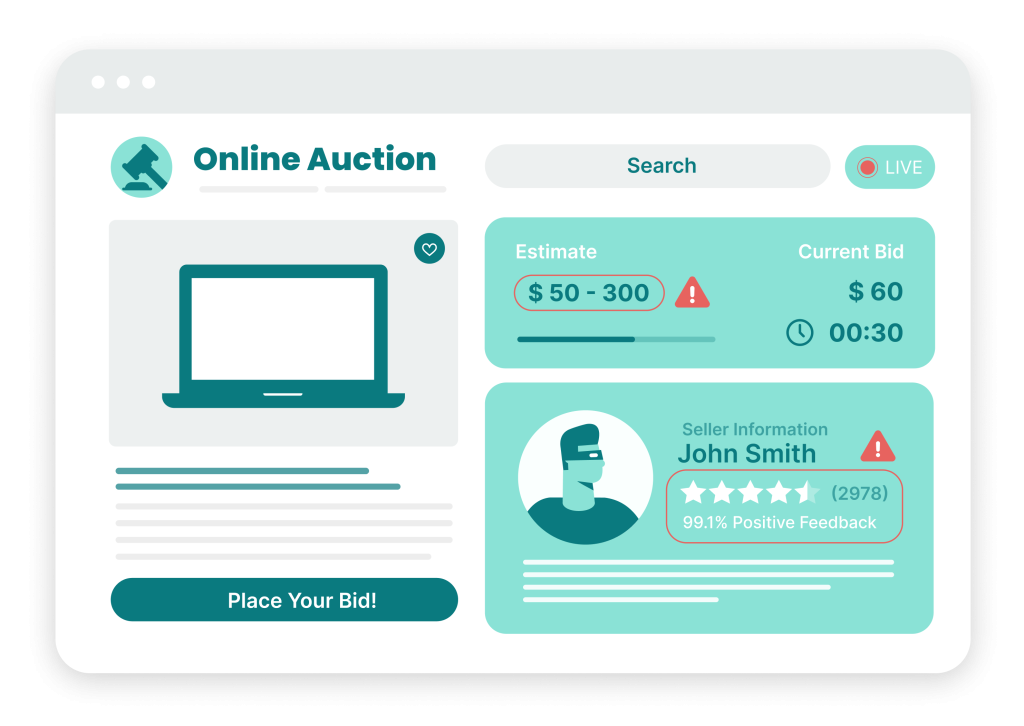What Is Auction Fraud?
Auction fraud is any and all fraud happening on auction sites. It comes in multiple forms depending on the exact mechanics, with varying risks of chargebacks and to the platform’s reputation.
In its most basic form, auction fraud starts with a fake listing – putting up an item that’s in some form falsely advertised – and can go over into delivery, with sellers receiving the funds but never delivering the item.
As online auction sites became popular, fraudsters have been targeting them in various ways in order to make some quick money. However, it’s interesting to note that this type of fraud is one of the oldest ones in the online world, taking off in the early ‘00s on eBay.
The fact that a 2004 report in the Journal of Economic Crime Management wrote that “During the first six months of 2001, internet auction fraud accounted for approximately 70% of fraud reports made to the Internet Fraud Watch” shows just how common online auction fraud has been for decades.
Twenty-one years later, 40,914 cases of auction fraud and online shopping fraud were reported just in the UK for the first six months of 2020 per Action Fraud UK/Statista.

How Does Auction Fraud Work?
- A malicious seller account is set up, sometimes listing items that are typically not owned by the seller.
- Often, fraudsters use (an)other account(s) to “bid” for the item, buy fake reviews or complete a couple of “normal” auctions before scamming legitimate buyers with fake items.
In other cases, it’s a part of triangulation fraud, where fraudsters use stolen credit cards to deliver on the goods buyers have bid for, but more often than not they just simply pocket the cash and fail to deliver anything.
At this point, the auction site or marketplace is notified by an understandably angry customer, and chargeback requests are made to the card issuers.
4 Examples of Auction Fraud
Auction fraud can be as varied and wide-ranging as ecommerce fraud itself. Some of the more common examples include:
- Non-delivery auction fraud: The item was never there to begin with, so the fraudster doesn’t deliver it to the customer.
- Misrepresentation auction fraud: The item is not in fact what is advertised, but some knock-off or counterfeit that will ship from overseas.
- Triangulation auction fraud: The item is delivered but the malicious seller has purchased it with a stolen credit card using the customer’s billing details as a delivery address. The customer is none the wiser that they have just purchased stolen goods.
- Account takeover: Legitimate seller and buyer accounts at auction websites are taken over by cybercriminals, who then use them to commit the types of fraud listed above, or simply tap into saved card details, payment gateway and digital wallet accounts, where available.
How to Avoid Auction Fraud
As a consumer, always be wary of too good to be true deals. As a marketplace, be aware that auction fraud is usually a culmination of many things, so you should be proactively monitoring seller accounts for suspicious behavior.
Some signs to watch out for
Fake reviews: Scammers have to build up their credibility somehow, and there are a variety of review services available for them – including some they could set up themselves, using bots or other methods.
Collusion between accounts: Another way to manipulate ratings is by setting up fake buyer accounts to vouch for fraudulent seller accounts, using fake transactions to avoid scrutiny. These can also help out in pushing the bids up to secure more profits.
Suspicious seller signups: You know what the typical seller on your ecommerce marketplace looks like. The fraudsters do not. They’ll often do a poor job at hiding it too, and you can block them shortly after signup until further verification – which might scare them off.
Monitor listings: Too good to be true deals should be flagged by the platform as suspicious, as well as items blatantly ripped from other sellers or websites.
Keeping the above in mind in conjunction with appropriate anti-fraud and cybersecurity solutions, as well as making use of industry best practices including KYC workflows and efficient device fingerprinting, will go a long way in keeping the platform, shoppers and sellers safe.
From marketplaces to major online sellers, every and any online store can be a target of fraud. Learn more about it to protect your bottom line better.
Read more
Sources
FBI.gov: Scams and Safety: Internet auction fraud
Statista: Number of online shopping fraud incidents in the UK
Utica: Internet auction fraud: The silent victims








